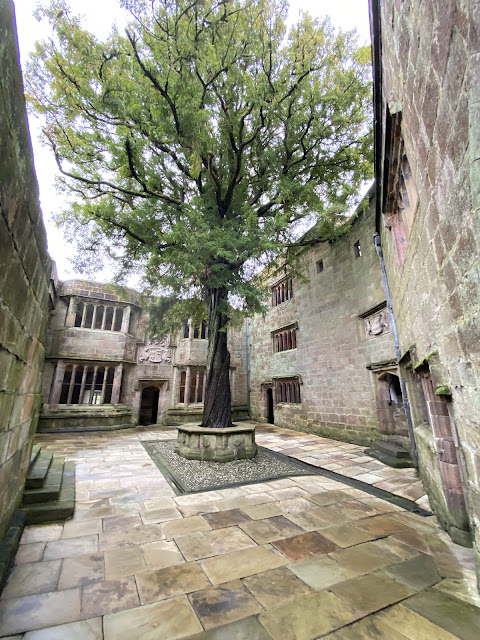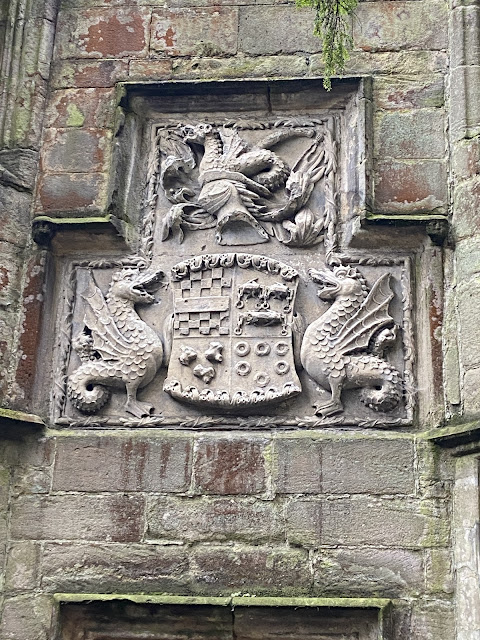Monday 30th September - Wednesday 2nd October.
The drive from home to Skipton was horrible as the weather was shocking and the spray from trucks and vans made driving quite challenging. We were glad when we arrived on the bus station carpark in Skipton, donned waterproofs and headed off for a calming coffee in the very nice and spotless Caffe Capo.
Then it was a short drive to the Skipton hotel for afternoon tea, an hour in the gym and then a swim and a sauna before a beer and dinner. All very pleasant and relaxing.
The hotel is right on the towpath of the Leeds- Liverpool canal and its roughly 30 minutes walk into Skipton. So that was what the plan was going to be for the following morning.
Following a lovely breakfast we set off in light rain, luckily this didn't persist for long and I was becoming overheated in my Paramo Adventure lite jacket. I thought I had brought my Pertex Windproof with me but when I decided to change layers I found out it was actually a rucksack cover I had inadvertently brought. so I had to wear the Paramo all day.
The towpath is well used by cyclists who obviously find it easier to get into Skipton centre rather than driving with all tourist queues.
The town centre was quite busy even though it was a damp Tuesday morning. It's a busy hub and the roads need care when crossing. We headed for the church at the top of the very wide Main Street. It's an affluent place and so nice to see shops which were shutterless and quite quirky too. The coffee shops were doing a roaring trade. I definitely would not consider a visit here on a lovely summer day or even a weekend for that matter.
The church, The Anglican Holy Trinity was open to the public and it is a fine building.
The castle stands in a plot behind the church and commands great views. It is the most complete medieval castle in the UK and has been the home of the Clifford family.
There was a primitive fort built on this site around 1090 by Robert de Romille, a Norman Barron. However it was ransacked by the Scots numerous times and so a more substantial building was required.
The castle was granted to Robert Clifford by Edward 11 in 1310. Robert heavily fortified the castle but was killed at the Battle of Bannockburn in 1314.
Skipton remained the Cliffords principal seat until 1676. Their banner flies over the castle today with the approval of the present Lord Clifford of Chudleigh, Devon.
On visiting the gate house and reading the information board, it tells you how strong the castle was and that it was the last to surrender the civil war and how important it was to the royalist cause. But this could quite easily be a one sided story or as we say now,"Fake News".
January 1644 castle garrisoned by the Royalists but owned by a Parliamentarian – Philip Herbert, 4th Earl of Pembroke. As a result Earl of Newcastle made Sir John Mallory (Mallorie)(Royalist) Royal Governor of the castle. Meanwhile Lord Fairfax (Commander in Chief of the New Model Parliamentarian Army) had been in contact with Pembroke asking if he had a problem with the taking of the castle. Pembroke responded that he did not but would take it kindly if he did not knock it about too much!
Perhaps this was one of the main reasons why Skipton survived so long.
Many of the castles Royalist foot soldiers and officers had been requisitioned to fight on other fronts and many were killed. Leaving the castle garrison light.
After the siege of York only a few castles were left in Royalist control and Skipton was one. Skipton had so far been untroubled from the Parliamentary forces.
After the fall of Pontefract and Scarborough castles fell to the Parliamentarians only Skipton, Sandal and Bolton remained Royalist.
Next sandal castle surrendered tot he parliamentarians, and a little later Bolton surrendered. Leaving only Skipton in Royalist arms.
A rather curious incident occurred next. The York Parliamentarian Committee, wanting to secure the surrender of Skipton castle, started negotiations without surrounding the castle. It appears though that the trumpeter sent by Mallory got himself well and truly drunk and never arrived in York! I’m sure there’s a Living History scenario to be created here. The garrison had to apologise and restart the negotiations which went nowhere as Mallory’s requests were unmeetable.
November saw the re-commencing of the siege again under Colonel Richard Thornton with 2000 foot and 2000 horse. It took three days of hard fighting to take the town as Mallory had learnt from the first siege and no doubt erected barricades and blocked alleys.
Having taken the town Thornton now called for the siege guns to be sent from York. It’s not clear when the heavy guns arrived, but considering the weather conditions of the period it is likely to have taken longer than Thornton wanted. Thornton had wisely used the time waiting for them as his troops had built earthworks for the cannon on Park, Sod and Cock hills. As the artillery battered down the walls and the church steeple it was inevitable that the garrison would have to surrender. On 21st December surrender articles were agreed. The garrison could march out with the ‘honours of war’ and be provided with an escort to take them to Nottinghamshire.
So the castle had basically stayed in Royalist control due to being a lack of heavy artillery being brought to bear. When canon did finally barrage the castle it lasted only a short time before it surrendered. There was not massive damage done and even the castles cafe which is still open to this day looks to have escaped unscathed.
So was it fake news? It would seem so.
To me the barrage also seems to have been done in the wrong place. If you look at the map of Skipton and see the "Battery" position to the NW of the castle, this is the castles most formidable face and hardly the easiest place to fight. The easiest place would have been from the south west. Maybe, as said earlier, the roundheads were asked not to do too much damage on taking the castle.
Here are some photos of the castle today and it is a pity that it isn't furnished at all.
The Privey, or Long Drop. Placed high above a stream or cliff. A heap of soft spongy moss replacing todays toilet paper.
The Coat of Arms of John Clifford, ninth Lord of Skipton. 1461. He was known as "The Butcher".
The curing room shallow sink. Used in the meat preservation process.
A Charcoal burning stove provided cleaner burning than wood in the new kitchen
The Castle and the connection to Lady Anne Clifford.
Lady Anne Clifford Countess of Dorset, Pembroke and Montgomery, 1590 - 1676.
Born in Skipton Castle on 30th January 1590.
In 1605 she became 14th Baroness de Clifford.
She was a Patron of Literature and in the period between 1653-1676 she was High Sherif of Westmoreland.
Anne fought legal battles to regain her family estates from her fathers brother which she eventually did in 1649. This was a great win for her in those early times.
With her now fortune she did large building works on Skipton, Pendragon, Brough, Appleby and Brougham castles and numerous churches.
She was heavily involved with her tenants to the point of filing lawsuits against them and actively pursuing rents and debts owed to her. This was to be the demeanour of her power in later life, that of a direct landowner calling upon the traditions of the baronial class.
After moving north, she rotated her residence amongst her castles, living in various ones for several months to a year at a time. She died aged 86 at Brougham Castle, in the room in which her father had been born and her mother had died.
Her tomb and monument is in St Lawrences church, Appleby in Westmoreland.
There is also a long distance trail called, "The Lady Anne Way". Obviously put lots of thought into the title. It is 100 miles long and goes between Skipton and Penrith. It is classed as Challenging.



















































